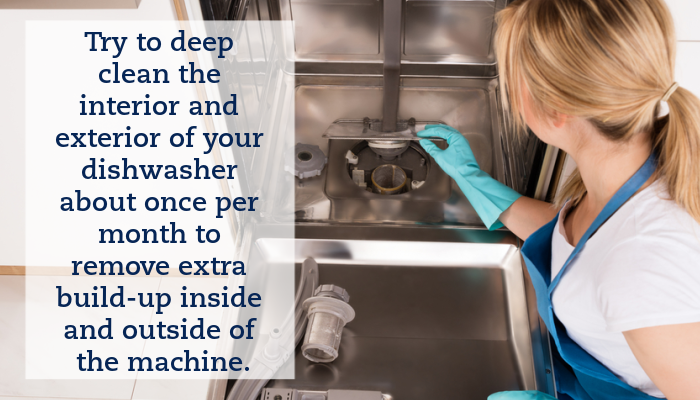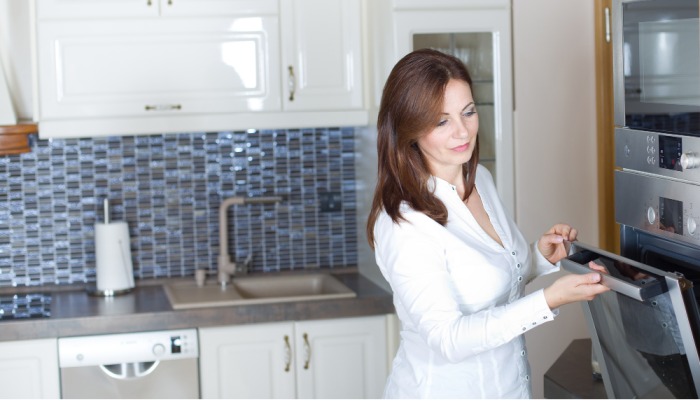Many of us are spending more time indoors than ever before, and our appliances are getting far more use than usual. For that reason, knowing how to clean and maintain your oven, washer, dryer, dishwasher, and other appliances is particularly important right now.
It may come as a surprise that dishwashers and washer machines do not actually wash themselves, despite the number of times they run soap and hot water through their systems. In addition to the dishwasher and washer machine, the dryer should receive a little extra attention when deep cleaning appliances as well, as forgetting to clean the lint out of a dryer can pose a serious fire risk.
While these cleanliness tips apply to any renter, they are particularly applicable to those who are caring for someone who was recently sick—as pathogens can work their way into appliances and affect clothing and dishware.
It is important to note a few important safety tips:
- If your washer/dryer has been through a flood or fire in the past, do not clean it until you have a technician check the electronics component in your appliances.
- There are several cleaning methods that involve using bleach or vinegar when cleaning appliances. While both cleaning products work well on their own, bleach and vinegar should never be mixed.
The Dishwasher
Although it frequently runs soap and hot water through its system, a dishwasher still need some TLC in order to run at its best. Here’s how to get your dishwasher squeaky clean:
Step #1: Clean out the filter
Remove all racks and trays from the dishwasher to gain access to the filter, which will need to be removed manually. Unscrew the cylinder in the center and clean all parts of the filter using soap, warm water, and a toothbrush.
Step #2: Disinfect the dishwasher’s interior
When food and liquids run through the dishwasher, they can leave a lingering odor. To eliminate residue from food build up, place two cups of white vinegar at the bottom of the dishwasher and run the machine through a normal cycle without dishwasher detergent.
Step #3: Clean the dishwasher’s exterior
Cleaning the exterior of a stainless-steel dishwasher will involve a different cleaning method than a dishwasher with a plastic exterior.
If you have a stainless-steel dishwasher, combine ¾ of a cup of undiluted white vinegar with 1 and ¼ of a cup of warm water. Use a soft towel or sponge and gently clean the machine’s exterior. In addition to the white vinegar mixture, over-the-counter cleaners can be purchased to help clean the exterior of the machine. For washer machines with plastic covers, simply use soapy water and a sponge to give it a deep clean.
How often should I deep clean my dishwasher?
Try to deep clean the interior and exterior of your dishwasher about once per month to remove extra build-up inside and outside of the machine.
Many of us are spending more time indoors than ever before, and our appliances are getting far more use than usual. For that reason, knowing how to clean and maintain your oven, washer, dryer, dishwasher, and other appliances is particularly important right now.
The Washing Machine
When used frequently, a washing machine can produce a musty odor, especially when fabric softener is used. Viral particles and pathogens can survive on clothing even after going through the washer machine, so it is important to sanitize your washer machine every few months. If you have recently washed clothing that contains poison ivy, pesticides, or chemicals, it is especially important to deep-clean your washing machine to remove any trace of unwanted contaminants.
Option #1: Clean the interior using white vinegar
To clean out the washer machine’s interior, fill the washer machine with hot water. Then, place one cup of white vinegar into the washer machine’s bleach dispenser or directly into the machine and run it for one minute to mix the vinegar and water together. If you are cleaning a top-loading machine, open the lid and let the vinegar and water mixture sit for one hour. At the end of the hour, complete the cycle. If it is a front-loading machine, press “pause” and let it sit for an hour. After the hour is up, complete the cycle.
Option #2: Deep clean the interior using bleach
Four times per year, deep clean the interior of your machine with bleach. To do so, place one cup of bleach in the washing machine’s bleach dispenser and follow the same process used for white vinegar in step #1. Mold and mildew tends to hide inside washing machines, and bleach is an excellent disinfectant that will help kill those spores. If you prefer not to use chemicals, the vinegar method detailed above works very well.
Step #3: Use an over-the-counter cleaner
If you own a High-Efficiency (HE) washing machine, there are several effective cleaners that can be purchased at your local hardware or grocery store. Many of these over-the-counter cleaners not only deep-clean the inside of the washing machine, but also have cleaners for cleaning out the trays, door, gasket, and all other exterior surfaces on the washing machine.
How often should I sanitize the inside of my washing machine?
Sanitize your washing machine using white vinegar about once a month and deep clean the machine with bleach about four times per year.
The Dryer
Lint should be removed from the dryer’s filter before every load of laundry. Lint build-up in the dryer can be a fire hazard, so this is an important step. In addition to manually removing the lint every time you put in a new load, the filter should also be gently rinsed under the sink with warm soapy water and a soft toothbrush to remove any excess lint.
The Oven
While most ovens have a self-cleaning feature that can be used, that doesn’t always do the trick when removing extra grease and grime build-up. Chemical oven cleaners are effective in removing build-up, but they can pose a serious health hazard as many cleaners are dangerous to inhale. Rather than using dangerous chemicals, it is best to make your own non-toxic cleaning solution using vinegar or baking soda.
Option #1: Clean the oven using baking soda and vinegar
Sprinkle the bottom of the oven with baking soda. Put white vinegar in a spray bottle, and spray the vinegar directly onto the baking soda—this will cause the baking soda to bubble. Allow the vinegar and baking soda to sit for about four hours overnight, and then wipe away the mixture using a damp rag or sponge.
Option #2: Clean the oven only using a baking soda
If you don’t have vinegar, or prefer not to use vinegar, you can combine one cup of water with a little bit of baking soda to make a paste. Coat the inside of the oven, allow it to sit overnight, and then remove with a damp rag or sponge the next morning.
A/C Filter
The dirtier your A/C filter is, the more difficult it is to run, leading to higher electricity bills. A/C filters collect mold, bacteria, and dirt, which can impact the air quality and your overall respiratory health.
Step #1: Remove the filter
After turning the air conditioner off, remove the filter using a screwdriver. Some air conditioner units can be cleaned manually, while others should be replaced. Check the filter to see what kind you have, as cleaning a disposable air filter that should be replaced rather than cleaned can lead to mold issues.
Step #2: Vacuum the A/C filter
Use a vacuum hose to remove any dust or grime that has built-up in the filter.
Step #3: Soak the filter in water and vinegar
Fill a bucket or your sink with water and one cup of white vinegar and allow your A/C filter to soak for one hour. You can also clean it using a garden hose on a non-pressurized setting.
How often should I clean my A/C filter?
It is best to clean your A/C filter once per month when in use (particularly during the summer) to remove any toxins or bacteria in the air.
More Tips for Keeping Your Apartment Beautiful and Clean

The majority of people are spending more time inside the home than usual. That's why maintaining your apartment as a clean, safe, and pleasant space is more important than ever before.